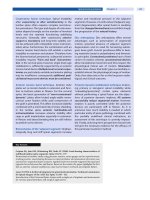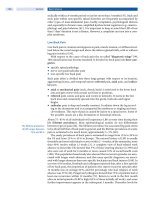Chapter 061. Disorders of Granulocytes and Monocytes (Part 7) pot
Bạn đang xem bản rút gọn của tài liệu. Xem và tải ngay bản đầy đủ của tài liệu tại đây (69.93 KB, 10 trang )
Chapter 061. Disorders of Granulocytes
and Monocytes
(Part 7)
Miscellaneous
Metabolic disorders—ketoacidosis, acute renal failure, eclampsia, acute
poisoning
Drugs—lithium
Other—metastatic carcinoma, acute hemorrhage or hemolysis
Abnormal Neutrophil Function
Inherited and acquired abnormalities of phagocyte function are listed in
Table 61-3. The resulting diseases are best considered in terms of the functional
defects of adherence, chemotaxis, and microbicidal activity. The distinguishing
features of the important inherited disorders of phagocyte function are shown in
Table 61-4.
Table 61-3 Types of Granulocyte and Monocyte Disorders
Cause of Indicated Dysfunction
Function Drug-Induced
Acquired
Inherited
Adherence-
aggregation
Aspirin,
colchicine, alcoho
l,
glucocorticoids,
ibuprofen, piroxicam
Neonatal
state,
hemodialysis
Leukocyte
adhesion
deficiency types 1
and 2
Deformability
Leukemia,
neonatal state,
diabetes mellitus,
immature
neutrophils
Chemokinesis-
Glucocorticoids
(high dose), auran
ofin,
Thermal
injury,
Chédiak-
Hig
ashi syndrome,
chemotaxis
colchicine (weak
effect),
phenylbutazone,
naproxen,
indomethacin,
interleukin 2
malignancy,
malnutrition,
periodontal
disease, neonatal
state, systemic
lupus
erythematosus,
rheumatoid
arthritis, diabetes
mellitus, sepsis,
influenza vi
rus
infection, herpes
simplex virus
infection,
acrodermatitis
enteropathica,
AIDS
neutrophil-specific
granule deficiency,
hyper IgE–
recurrent infection
(Job's) syndrome
(in some patients),
Down syndrome,
α-mannosidase
deficiency, severe
combined
immunodeficiency,
Wiskott-Aldrich
syndrome
Microbicidal
activity
Colchicine,
cyclophosphamide,
glucocorticoids (high
Leukemia,
aplastic anemia,
certain
Chédiak-
Higashi syndrome,
neutrophil-specific
dose), TNF-
α blocking
antibodies
neutropenias,
tuftsin
deficiency,
thermal injury,
sepsis, neonatal
state, diabetes
mellitus,
malnutrition,
AIDS
granule deficiency,
chronic
granulomatous
disease, defects in
IFN-γ/IL-12 axis
Table 61-4 Inherited Disorders of Phagocyte Function: Differential
Features
Clinical
Manifestations
Cellular or
Molecular Defects
Diagnosis
Chronic Granulomatous Diseases (70% X-
linked, 30% Autosomal
Recessive)
Severe infections of
skin, ears, lungs, liver, and
No respiratory
burst due to the lack of
NBT or DHR test;
no superoxide and H
2
O
2
bone with catalase-
positive
microorganisms such as
S.
aureus,
Burkholderia cepacia
, Aspergillus
spp.,
Chromobacterium violaceum
;
often hard to culture orga
nism;
excessive inflammation with
granulomas, frequent lymph
node suppuration; granulomas
can obstruct GI or GU tracts;
gingivitis, aphthous ulcers,
seborrheic dermatitis
one of four NADPH
oxidase subunits in
neutrop
hils, monocytes,
and eosinophils
production by
neutrophils; immunoblot
for NADPH oxidase
components; genetic
detection
Chédiak-Higashi Syndrome (Autosomal Recessive)
Recurrent pyogenic
infections, especially with
S.
aureus
; many patients get
lymphoma-
like illness during
adolescence; periodontal
disease; partial
Reduced
chemotaxis and
phagolysosome fusion,
in
creased respiratory
burst activity, defective
egress from marrow,
Giant primary
granules in neutrophils
and other granule-
bearing
cells (Wright's stain);
genetic detection
oculocutaneous albinism,
nystagmus, progressive
peripheral neuropathy, mental
retardation in some patients
abnormal skin window;
defect in LYST
Specific Granule Deficiency (Autosomal Recessive)
Recurrent infections of
skin, ears, and sinopulmonary
tract; delayed wound healing;
decreased inflammation;
bleeding diathesis
Abnormal
chemotaxis, impaired
respiratory burst and
bacterial killing, failure
to upregulate
chemotactic and
adhesion recept
ors with
stimulation, defect in
transcription of granule
proteins; defect in
C/EBPε
Lack of secondary
(specific) granules in
neutrophils (Wright's
stain), no neutrophil-
specific granule contents
(i.e., lactoferrin), no
defensins, platelet α
granule abnorma
lity;
genetic detection
Myeloperoxidase Deficiency (Autosomal Recessive)
Clinically normal
except in patients with
underlying disease such as
diabetes mellitus; then
candidiasis or other fungal
infections
No
myeloperoxidase due to
pre- and posttranslatio
nal
defects
No peroxidase in
neutrophils; genetic
detection
Leukocyte Adhesion Deficiency
Type 1: Delayed
separation of umbilical cord,
sustained neutrophilia,
recurrent infections of skin
and mucosa, gingivitis,
periodontal disease
Impaired
phagocyte ad
herence,
aggregation, spreading,
chemotaxis,
phagocytosis of C3bi-
coated particles;
defective production of
CD18 subunit common
to leukocyte integrins
Reduced
phagocyte surface
expression of the CD18-
containing integrins with
monoclonal antibodies
against LFA-
1
(CD18/CD11a), Mac-
1
or CR3 (CD18/CD11b),
p150,95 (CD18/CD11c);
genetic detection
Type 2: Mental
Impaired Reduced
retardation, short stature,
Bombay (hh) blood
phenotype, recurrent
infections, neutrophilia
phagocyte rolling along
endothelium
phagocy
te surface
expression of Sialyl-
Lewis
x
, with monoclonal
antibodies against
CD15s; genetic detection
Phagocyte Activation Defects (X-linked and Autosomal Recessive)
NEMO deficiency:
mild hypohidrotic ectodermal
dysplasia; broad based
immune defect: pyog
enic and
encapsulated bacteria, viruses,
Pneumocystis
, mycobacteria;
X-linked
Impaired
phagocyte activiation by
IL-1, IL-
18, TLR, CD40,
TNF-
α leading to
problems with
inflammation and
antibody production
Poor in vitro
response to endotoxin;
lack of NF-κB
activation;
genetic detection
IRAK4 deficiency:
susceptibility to pyogenic
bacteria such as staphylococci,
streptococci, clostridia;
Impaired
phagocyte activation by
endotoxin through TLR
and other pathways;
Poor in vitro
response to endotoxin;
lack of NF-
κB activation
by endotoxin; genetic
resistant to mycobacteria;
autosomal recessive
TNF-
α signaling
preserved
detection
Hyper IgE–
Recurrent Infection Syndrome (Autosomal Dominant)
(Job's Syndrome)
Eczematoid or pruritic
dermatitis, "cold" skin
abscesses, recurrent
pneumonias with S. aureus
with bronchopleural fistulae
and cyst formation, mild
eosinophilia, mucocutaneous
candidiasis, characteristic
facies, restrictive lung disease,
scoliosis, delayed primary
dental deciduation
Reduced
chemotaxis in some
patients, reduced
suppressor T cell activity
Clinical features,
involving lungs, skeleton,
and immune system;
serum IgE > 2000 IU/mL
Mycobacteria Susceptibility (Autosomal Dominant
and Recessive
Forms)
Severe local or
disseminated infections with
bacille Calmette-
Guérin
(BCG), nontuberculous
mycobacteria, salmonella,
histoplasmosis, poor
granuloma formation
Inability to kill
intracellular organisms
due to low IFN-
γ
production; mutat
ions in
IFN-γ receptors, IL-
12
receptor, IL-
12 p40,
STAT-1, NEMO
Low or very high
levels of IFN-
γ receptor
1; functional assays of
cytokine production and
response; genetic
detection
Abbreviations: GI, gastrointestinal; GU, genitourinary; NADPH,
nicotinamide-adenine dinucleotide phosphate, NBT, nitroblue tetrazolium (dye
test), DHR, dihydrorhodamine (oxidation test); LYST, lysosomal transport
protein; C/EBPε, CCAAT/enhancer binding protein-ε; NEMO, NF-κB essential
modulator; TLR, Toll-like receptor; IL, interleukin; TNF, tumor necrosis factor;
IRAK4, IL-1 receptor–associated kinase protein-ε, NEMO 4; IFN,
interferon.[newpage]









